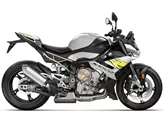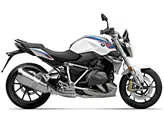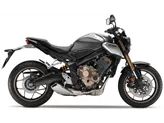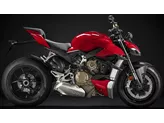Suzuki SV 650 2016 vs. BMW S 1000 R 2017

Suzuki SV 650 2016

BMW S 1000 R 2017
Visão geral - Suzuki SV 650 2016 vs BMW S 1000 R 2017
The Suzuki SV 650 2016 and the BMW S 1000 R 2017 are both naked bikes that offer powerful engines and advanced features. However, there are several key differences between the two models.
In terms of engine and power, the Suzuki SV 650 2016 is equipped with a V-twin engine that produces 76 horsepower and 64 Nm of torque. On the other hand, the BMW S 1000 R 2017 features an inline-four engine that delivers a significantly higher power output of 165 horsepower and 114 Nm of torque. This makes the BMW S 1000 R more powerful and capable of delivering a thrilling riding experience.
Both bikes feature fuel injection systems and liquid cooling for optimal performance. The Suzuki SV 650 2016 has a displacement of 645cc, while the BMW S 1000 R 2017 has a larger displacement of 999cc, resulting in more power and torque.
In terms of suspension, both bikes feature telescopic forks at the front and a swingarm with a monoshock at the rear. However, the BMW S 1000 R 2017 has the advantage of a dynamic suspension system, which automatically adjusts to provide optimal performance in different riding conditions. This feature enhances the overall riding experience and makes the BMW S 1000 R more versatile.

Suzuki SV 650 2016
The chassis of the Suzuki SV 650 2016 is made of steel, while the BMW S 1000 R 2017 features an aluminum frame. The use of aluminum in the BMW S 1000 R results in a lighter overall weight and improved maneuverability.
Both bikes are equipped with dual disc brakes at the front, but the BMW S 1000 R has the advantage of four-piston calipers, providing more stopping power and better control. Additionally, both bikes come with ABS as a standard feature, ensuring safe and reliable braking performance.
In terms of dimensions, the Suzuki SV 650 2016 has a narrower front tire width of 120mm, compared to the BMW S 1000 R 2017's 190mm width. The Suzuki SV 650 2016 also has a shorter wheelbase of 1445mm, while the BMW S 1000 R 2017 has a slightly shorter seat height of 785mm.

BMW S 1000 R 2017
In terms of weight, the Suzuki SV 650 2016 weighs 197kg with ABS, while the BMW S 1000 R 2017 weighs slightly more at 205kg with ABS. Both bikes have fuel tanks with decent capacities, with the Suzuki SV 650 2016 having a 13.8-liter tank and the BMW S 1000 R 2017 having a larger 17.5-liter tank.
In terms of strengths, the Suzuki SV 650 2016 offers an agile and powerful engine, a comfortable seating position, and easy handling. It also has a comfortable chassis and brakes with good control. On the other hand, the BMW S 1000 R 2017 is praised for its excellent gear shifting assistant, powerful engine, fantastic sound, and superb maneuverability. It also offers a wide range of equipment and accessory options, as well as powerful brakes. The BMW S 1000 R also has the advantage of a semi-active suspension system, which eliminates the need for manual adjustment.
In terms of weaknesses, the Suzuki SV 650 2016 has a digital tachometer that is not very legible. The BMW S 1000 R 2017, on the other hand, has original tires that are not of the highest quality and an inactive sitting position on the racetrack.
Overall, the Suzuki SV 650 2016 and the BMW S 1000 R 2017 are both impressive naked bikes with their own strengths and weaknesses. The Suzuki SV 650 2016 offers a more affordable option with decent power and handling, while the BMW S 1000 R 2017 provides a more powerful and versatile riding experience with advanced features and options.
Especificações técnicas Suzuki SV 650 2016 em comparação com BMW S 1000 R 2017
Prós e contras em comparação
Prós e contras em comparação
Suzuki SV 650 2016

A nova SV650 continua o minimalismo visual das duas primeiras gerações da SV650, mas baseia-se tecnicamente na sua antecessora direta, a SFV650 Gladius - duas excelentes jogadas que transformam a muito moderna SV650 num clássico. O design enquadra-se perfeitamente na era de muitas conversões retro, mas no interior também existem truques modernos que facilitam o arranque, especialmente para os principiantes. O motor, por outro lado, também pode convencer os condutores avançados; a sensação típica da V2 é maravilhosa. Não se deve esperar extrema desportividade no chassis e nos travões, mas o preço de pouco menos de 6400 euros (na Alemanha) é uma afirmação que a concorrência terá de engolir.
BMW S 1000 R 2017

O talento universal da BMW também melhorou em 2017. O BMW oferece a mais ampla gama de utilização e um motor excecionalmente cultivado, uma caixa de velocidades perfeita e o melhor assistente de mudança de velocidades no terreno. A condução é simples mas rápida. Sente-se bastante baixo no veículo.
Comparação de preços Preço médio de mercado Suzuki SV 650 vs BMW S 1000 R
There are a few key differences between a Suzuki SV 650 2016 and a BMW S 1000 R 2017. In terms of price, the actual average price of a BMW S 1000 R 2017 is about 130% higher. Compared to BMW S 1000 R 2017 there are less Suzuki SV 650 2016 bikes available on the 1000PS.de Marketplace, specifically 11 compared to 22. It takes less time to sell a Suzuki SV 650 with 80 days compared to 97 days for a BMW S 1000 R. Since model year 2005 1000PS.de editors have written 25 reviews for the Suzuki SV 650 and 62 reviews for the BMW S 1000 R since model year 2014. The first review for the Suzuki SV 650 was published on 26/09/2008 and now has more than 14.200 views. This compares to more than 17.300 views for the first review on BMW S 1000 R published on 03/11/2013.























